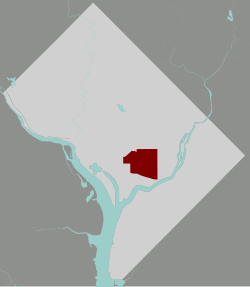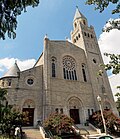Capitol Hill
Capitol Hill is the largest historic residential neighborhood in Washington D.C.. The neighborhood covers an area east of the United States Capitol along wide avenues. It is one of the oldest residential communities in Washington. Its two square miles house 35,000 people, so it is one of the most densely populated neighborhoods. The phrase "Capitol Hill" can sometime mean the United States Congress instead of the neighborhood.
Capitol Hill Historic District | |
 | |
G Street SE | |
Map of Washington, D.C., with the Capitol Hill Historic District highlighted in maroon | |
| Location: | Roughly bounded by Virginia Ave., SE., S. Capitol St., G St. NE., and 14th Sts. SE & NE; and roughly bounded by 8th St. NE, I-295, M St. SE and 11th St. SE Washington, D.C. |
|---|---|
| Coordinates: | 38°53′23″N 77°00′40″W / 38.88972°N 77.01111°WCoordinates: 38°53′23″N 77°00′40″W / 38.88972°N 77.01111°W |
| NRHP Reference#: | 76002127 (original) 03000585 (increase) |
| Significant dates | |
| Added to NRHP: | August 27, 1976 |
| Boundary increase: | July 3, 2003 |
Capitol Hill is also a hill as well as a neighborhood. The hill rises in the center of the District of Columbia and extends eastward. Pierre L'Enfant, as he began to develop his plan for the new Federal City in 1791, chose to locate the "Congress House" on the crest of the hill, facing the city, a site that L'Enfant characterized as a "pedestal waiting for a monument."
A large portion of the neighborhood is now designated as the Capitol Hill historic district. The name Capitol Hill is often used to refer to both the historic district and to the larger neighborhood around it. To the east of Capitol Hill lies the Anacostia River, to the north is the H Street corridor, to the south are the Southeast/Southwest Freeway and the Washington Navy Yard, and to the west are the National Mall and the city's central business district.
History
L'Enfant referred to the hill chosen as the site of the future Congress House as "Jenkins Hill" or "Jenkins Heights." However, the tract of land had for many years belonged to the Carroll family and was noted in their records of ownership as "New Troy." Some people have said that a man named Jenkins had once pastured some livestock at the site of the Capitol (and thus his name was associated with the site), artist John Trumbull, who would paint several murals inside the Capitol's rotunda, reported in 1791 that the site was covered with a thick wood, making it an unlikely place for livestock to graze. Noone knows who Jenkins was and how his name became associated with the hill, as reported by L'Enfant.[1]
The neighborhood that is now called Capitol Hill started to develop when the government began work at two locations, the Capitol and the Washington Navy Yard. It became a distinct community between 1799 and 1810 as the federal government became a major employer. The first stage in its early history was that of a boarding house community developed for members of Congress. In the early years of the Republic, few Congressmen wished to establish permanent residence in the city. Instead, most preferred to live in boarding houses within walking distance of the Capitol.
In 1799 the Washington Navy Yard was established on the banks of the Anacostia River, and provided jobs to craftsmen who built and repaired ships. Many of the craftsmen who were employed both at the Navy Yard and in the construction of the Capitol chose to live within walking distance, to the east of the Capitol and the north of the Navy Yard. They became the original residential population of the neighborhood. In 1806, President Thomas Jefferson selected the location of the Marine Barracks, which had to be within marching distance of both the Capitol and the White House, not far from the Washington Navy Yard. By 1810, shops, goldsmiths, blacksmiths, and churches were flourishing in the area.
The Civil War resulted in more building in the Capitol Hill area, including new hospitals. Building new houses continued in the 1870s and 1880s. The neighborhood began to divide along racial and economic class lines.
Electricity, piped water, and plumbing were introduced in the 1890s, and were first available in the downtown areas of the District of Columbia, including Capitol Hill. There was a real estate development boom between 1890 and 1910 as the Capitol Hill area became one of the first neighborhoods having these modern conveniences.
In 1976, the National Park Service added the Capitol Hill Historic District to the National Register of Historic Places. It is one of the largest historic districts in the United States. The boundaries of the historic district are irregular, extending southward from F Street NE, as far east as 14th Street, as far west as South Capitol Street, and with a southern limit marked chiefly by Virginia Avenue but including some territory as far south as M Street SE. It includes buildings from the Federal period (1800 to 1820) through 1919, but most of the buildings are late Victorian.
Capitol Hill has remained a fairly stable middle-class neighborhood throughout its existence. It suffered a period of economic decline and rising crime in the mid-20th century but gradually recovered. During the so-called "Crack Epidemic" of the 1980s, its fringes were often affected. More recently, the neighborhood has undergone intense gentrification.
Description
Capitol Hill's landmarks include not only the United States Capitol, but also the Senate and House office buildings, the Supreme Court building, the Library of Congress, the Marine Barracks, the Washington Navy Yard, and Congressional Cemetery.
It is, however, largely a residential neighborhood composed predominantly of rowhouses of different stylistic varieties and periods. Side by side exist early 19th century manor houses, Federal townhouses, small frame dwellings, ornate Italianate bracketed houses and the late 19th century press brick rowhouses with their often whimsical decorative elements combining Richardsonian Romanesque, Queen Anne, and Eastlakian motifs.
The main shopping corridor of Capitol Hill is Pennsylvania Avenue. It has shops, restaurants and bars. Eastern Market is an 1873 public market on 7th Street SE, where vendors sell fresh meat and produce in indoor stalls and at outdoor farmers' stands. It is also the site of an outdoor flea market every weekend. After a major fire gutted the main market building on April 30, 2007, it underwent restoration and reopened on June 26, 2009.
Barracks Row (8th Street SE), so called because of its proximity to the U.S. Marine Barracks, is one of the city's oldest commercial corridors. It dates to the late 18th century and has recently been revitalized.
More recently, the Old Naval Hospital has been converted into Hill Center, a new community center.[2] It is at the corner of 9th and Pennsylvania Avenue SE. The rehabilitation of the Old Naval Hospital combines the restoration of a historically significant landmark with the cutting edge technologies of modern “green” architecture. Hill Center is a vibrant new home for cultural, educational and civic life on Capitol Hill.
Recent estimates in Capitol Hill newspapers suggest as many as a third of all Members of Congress live on Capitol Hill while in Washington.
Famous people who were born in the Capitol Hill neighborhood include John Philip Sousa (whose birthplace, on G St., is still standing) and J. Edgar Hoover. Frederick Douglass's former house can be found in the 300 block of A Street Northeast. (In the 1970s the Douglass house was later used as an African Art Museum by Warren M. Robbins). Capitol Hill has several local community newspapers, such as the Hill Rag. The Voice of the Hill[dead link] closed in May 2010.[3]
Capitol Hill Media
A view of Capitol Hill and Navy Yard below, in 1833.
The Marine Barracks, established in 1801, are the oldest U.S. Marines facility and their main ceremonial ground. It is also the residence of the Commandant of the Marine Corps.
Old Naval Hospital, built in 1866.
The Supreme Court, built in 1935.
Eastern Market, a public market and food hall, was built in 1873.
The Folger Shakespeare Library, the world's largest collection of works by William Shakespeare and a primary repository for rare materials from the early modern period of Europe.
The Emancipation Memorial at Lincoln Park, erected in 1876.
References
- ↑ Vlach, John Michael (Spring 2004). "The Mysterious Mr. Jenkins of Jenkins Hill". United States Capitol Historical Society. Archived from the original on 2008-07-05. Retrieved 2008-08-20.
- ↑ "Old Naval Hospital". National Library of Medicine. Retrieved July 17, 2011.
- ↑ "Voice to cease publication | FRONT PAGE | The Voice of the Hill | Capitol Hill Current". Archived from the original on 2010-12-22. Retrieved 2011-07-17.












